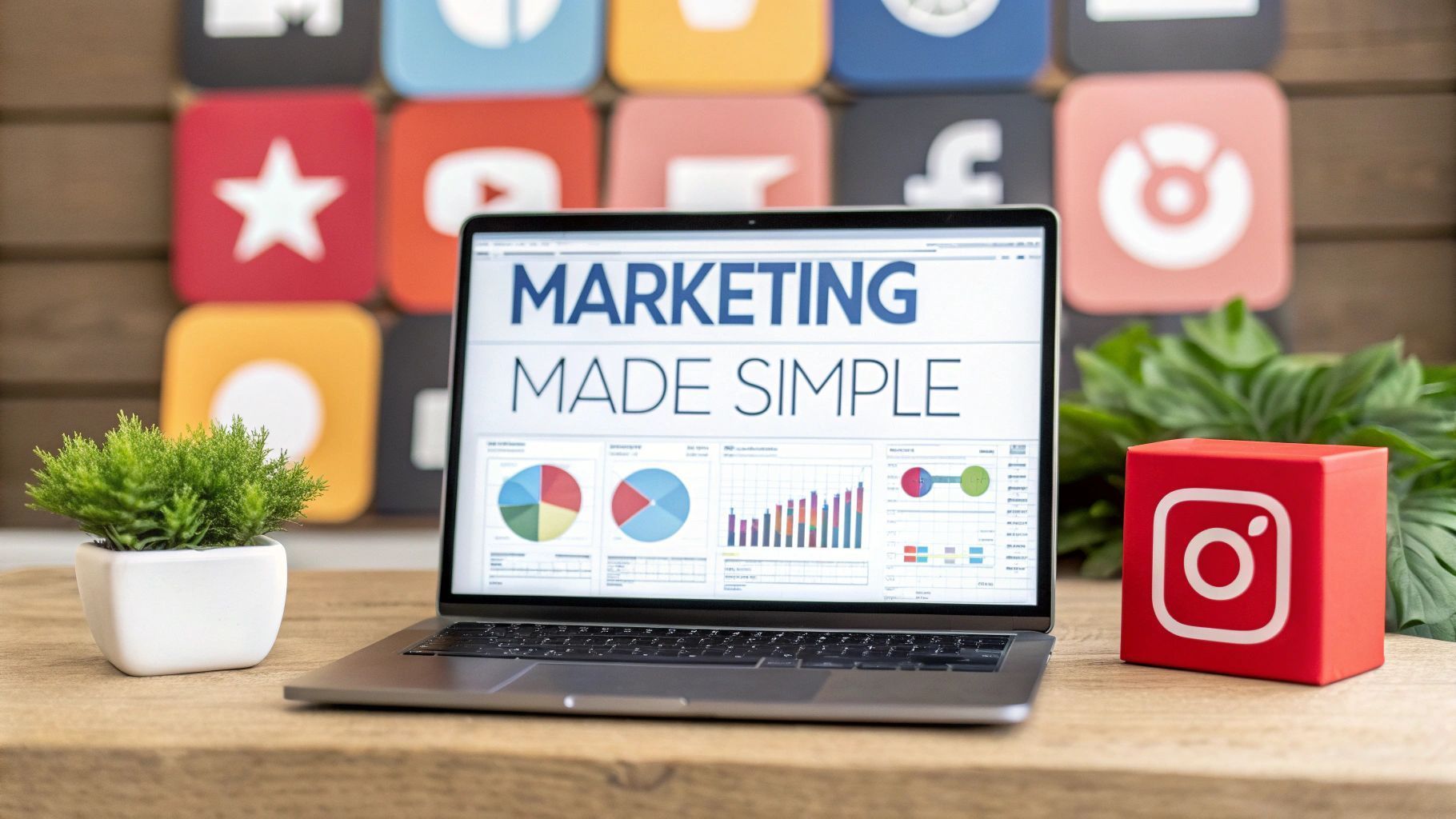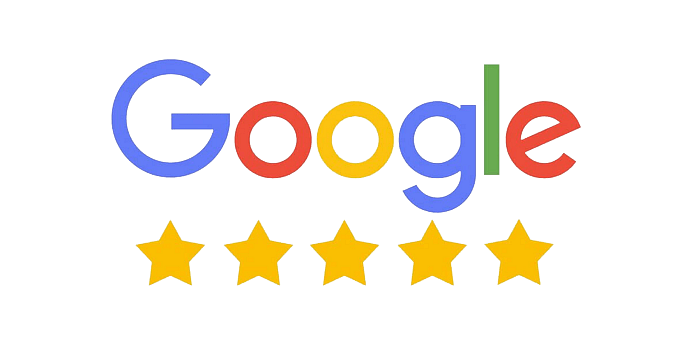Unlocking Growth with Content Marketing Services
Content marketing services aren't just about churning out articles or social media posts. Think of them as a complete professional toolkit designed to plan, create, share and measure content with a clear purpose in mind. The real goal is to build trust with your audience and position your brand as the go-to authority, attracting and keeping customers through valuable information, not just sales pitches.
What Exactly Are Content Marketing Services?

Imagine you're building a house. You wouldn't just start laying bricks and hope for the best. You’d bring in specialists: an architect for the blueprint, builders for the structure and electricians to handle the wiring. Each expert plays a critical part in making the project a success.
Content marketing services work in much the same way for your business. It’s not about random acts of content. It’s a structured, end-to-end approach that turns content into a powerful engine for growth.
This process covers every stage of your content’s life, moving your marketing away from old-school interruptive ads and towards a more natural way of attracting the right people to your brand.
The Foundational Pillars of Content Services
To really get what these services are all about, it helps to break them down into their core parts. Each one supports the next, creating a solid framework that delivers real, measurable results.
- Strategy: This is your architectural blueprint. It maps out who you’re talking to, what you want to achieve, what your core message is and which channels you'll use to reach your ideal customers.
- Creation: This is the construction phase. It’s where high-quality, relevant content gets made—think blog posts, videos, case studies or infographics, all crafted to meet your audience's needs.
- Promotion: This is your distribution network. Great content is useless if no one sees it. This part focuses on getting your message in front of the right eyes through SEO, social media and email marketing.
- Analysis: This is the final inspection. By tracking key metrics, a good provider measures what’s working and what isn’t, allowing the strategy to be constantly tweaked and improved.
These pillars work together to build a genuine connection with your audience. For a deeper dive, reviewing these 10 essential content marketing best practices is a great next step.
Beyond Production to Partnership
The ultimate goal here is to establish your brand as a credible, authoritative voice in your field. This goes way beyond just hitting a monthly content quota.
The core function of content marketing is to build trust. It is about consistently providing value to your audience so that when they are ready to make a purchase decision, your brand is the first one they think of.
This is all about understanding what your customers are trying to achieve. In fact, research shows 33% of people read blogs to learn something new , usually because they're looking for a solution to a problem.
Effective content services zero in on answering these questions and helping people solve a problem or get something done. This simple but powerful idea is central to understanding the role of content marketing in building brand authority. When you do this well, you stop being just another company selling a product and become an indispensable resource.
The Core Types of Content Marketing Services
Choosing the right content marketing services feels a bit like opening a mechanic's toolbox for the first time. There’s a whole array of tools, each designed for a specific job. The secret to success isn't just having the tools but knowing which one to use and when. Let's break down the main services you’ll come across from agencies and freelancers, so you can figure out what your business actually needs.
This graphic shows some of the most popular content marketing services that businesses are putting their money into.
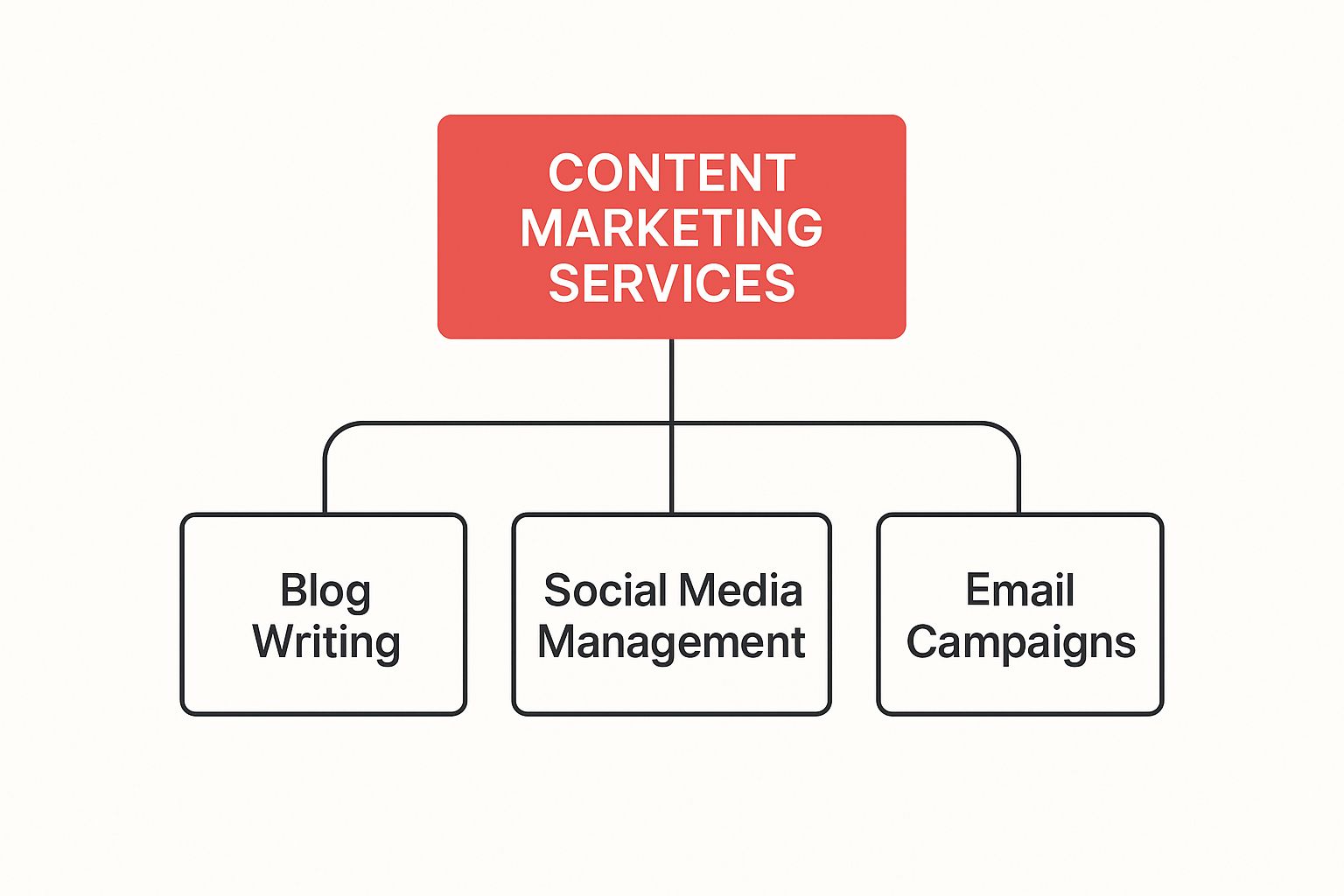
As you can see, foundational activities like blog writing, social media and email marketing are often the starting point for a much wider content strategy.
Content Strategy Development
Before a single word gets written, you need a plan. Think of strategy as the architectural blueprint for your entire content programme. It’s what ensures every single thing you create has a clear purpose.
A good content strategist dives deep into your business goals, gets to know your target audience inside and out and scopes out what your competitors are doing. From all that research, they build a comprehensive plan. This roadmap outlines what content you should create, where you should share it and how you’ll measure whether it's actually working.
Without a strategy, you’re just making noise. It’s the difference between building a house and just piling up bricks hoping for the best.
Multi-Format Content Creation
This is the engine room. Content creation is where ideas are hammered into shape, becoming real assets designed to grab your audience's attention, inform them and ultimately persuade them. But it’s not a one-size-fits-all game; different formats have different jobs.
- Blog Posts and Articles: These are the bedrock of most content strategies. They're perfect for building authority on a topic, answering customer questions and pulling in organic traffic from search engines.
- Video Content: From quick, punchy social media clips to detailed tutorials, video is an incredibly powerful way to tell a story or show off what your product or service can do.
- Infographics and Visuals: Got complex information to share? Turn it into an infographic. They're easy to digest, look great and are ridiculously shareable. In fact, infographics are 30 times more likely to be read than a block of text.
- Case Studies and White Papers: If you're in a more technical field, these long-form pieces are non-negotiable. They build serious credibility and generate leads by proving your expertise with real-world results.
In the UK, the demand for genuinely high-quality content is huge. Writing and editing are still king, with 90% of marketers agreeing that content creation is the single most important skill for success. This is mirrored in the freelance world, where writers make up a massive 69% of the marketing workforce . You can discover more fascinating UK content marketing statistics to see the full picture.
SEO Content Services
Making brilliant content is only half the job. If nobody can find it, it might as well not exist. That's where SEO content services come in. The entire focus is on making sure your content shows up when people search on Google.
This goes way beyond just sprinkling a few keywords in. A proper SEO specialist will do deep keyword research to understand the exact phrases your audience is typing into the search bar. They’ll then fine-tune your content’s structure, headings and all the technical bits and bobs to align with what search engines want to see.
The goal is simple: rank high for the searches that matter and drive a steady stream of qualified traffic straight to your website.
Content Distribution and Promotion
Once your content is created and optimised, it's time to get it out there. Just hitting 'publish' and hoping for the best won't cut it. A proactive distribution strategy is what ensures your content reaches the biggest, most relevant audience possible.
Promotion is the force multiplier for your content. Great content with no promotion is like a silent masterpiece—powerful but unseen. Effective promotion ensures your message resonates with the right people at the right time.
This service uses a mix of channels to get the word out:
- Social Media Marketing: Sharing your content on platforms like LinkedIn, Instagram or X to chat with your followers and find new ones.
- Email Marketing: Sending content directly to your subscribers' inboxes through newsletters. This is fantastic for nurturing leads and building stronger customer relationships.
- Paid Promotion: Using targeted ads on social media or search engines to put your content directly in front of a very specific audience.
Analytics and Reporting
Finally, how do you know if any of this is actually working? Analytics and reporting. This is how you prove the ROI of your content efforts and make smart, data-backed decisions to improve your strategy.
A good provider will track key performance indicators (KPIs) like website traffic, how long people stick around, conversion rates and lead generation. They'll then translate all that data into straightforward reports that show you exactly what impact your content is having on your business goals.
This creates a continuous feedback loop. You see what works, do more of it and ditch what doesn't. It closes the loop, turning performance data back into strategic action.
How Content Services Fuel Your Entire Marketing Engine
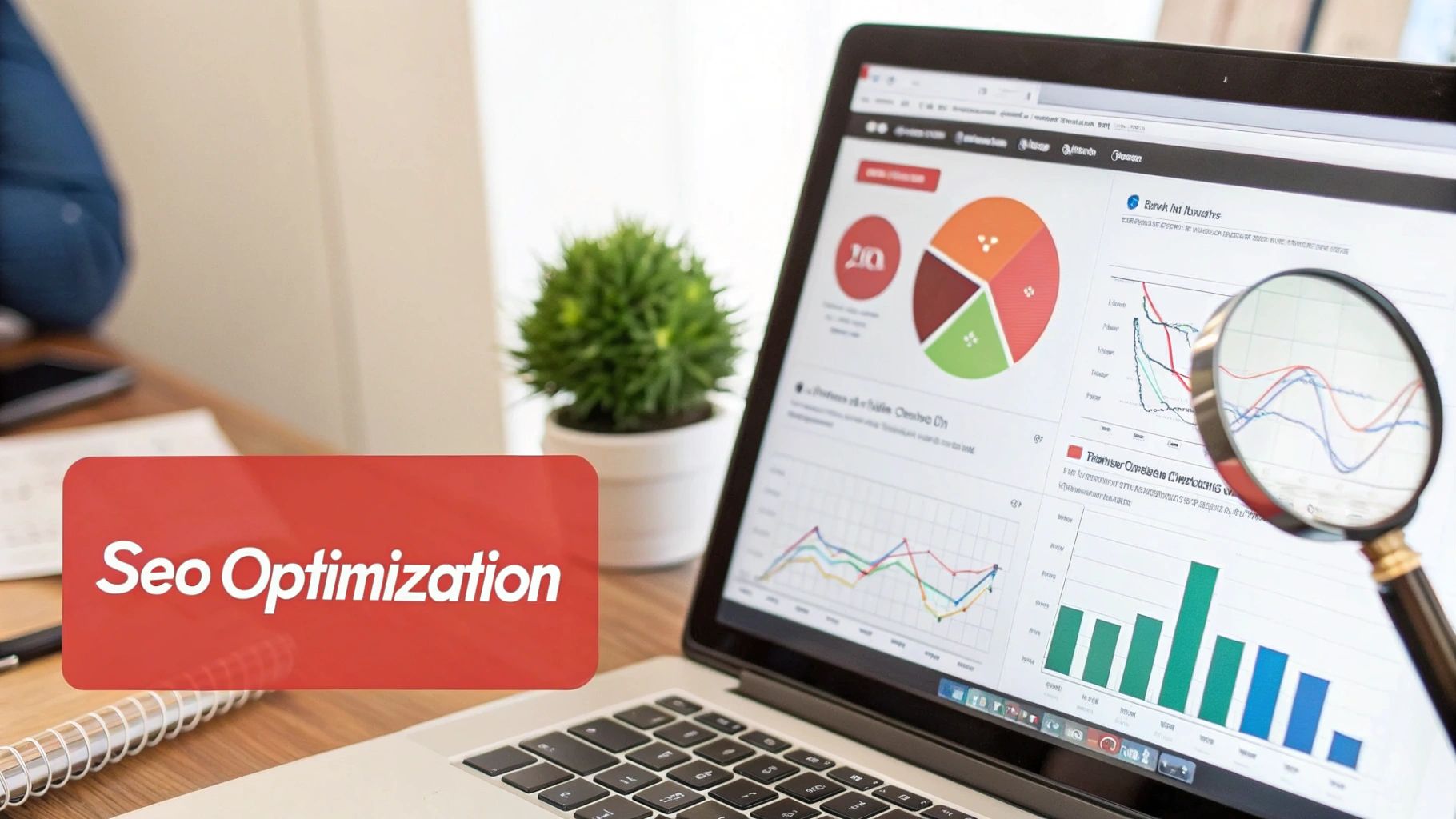
It’s easy to think of content marketing as just another channel, tucked away in its own little silo. But that perspective completely misses the point. A strong content programme isn’t just another piece of the puzzle; it's the central hub that powers every other part of your marketing. Get it right and it creates a powerful multiplier effect across everything you do.
Think of it like the engine in a high-performance car. You can have the best wheels and the most aerodynamic body but without a powerful engine, the car isn't going anywhere fast. High-quality content is that engine for your entire marketing machine.
This "hub and spoke" model is the key. The central content hub produces valuable assets—blog posts, videos, case studies—which then become the fuel for the "spokes," like your social media, email campaigns and paid ads. Each channel suddenly becomes far more effective because it's running on strategic, high-value content.
Boosting Your Search Engine Visibility
SEO and content are two sides of the same coin. You really can't have one without the other. Search engines like Google rely on great content to figure out what your website is about and why it deserves to rank for certain searches.
Every well-researched blog post or guide you publish creates a new opportunity for your site to be found. It’s like putting up another signpost online, telling search engines you're a knowledgeable authority in your field. This consistent creation of valuable material is exactly what builds the topical authority you need for long-term organic growth.
The numbers back this up. In the UK, 77% of businesses are actively investing in SEO and a huge chunk of that investment goes directly into content. They know it's the primary driver of search performance.
Amplifying Your Social Media Presence
Your social media channels need a constant stream of interesting stuff to keep your audience from scrolling past. Without quality content, your feeds just become a repetitive loop of sales pitches that people quickly learn to tune out.
This is where your content programme provides the ammunition. A single, solid blog post can be cleverly repurposed into dozens of different social media assets.
- Key statistics can become eye-catching graphics for Instagram.
- Important quotes can be turned into thought-provoking posts on LinkedIn.
- The core ideas can be summed up in a short, punchy video for TikTok or X.
Suddenly, your social media transforms from a simple broadcast channel into a genuine platform for conversation and community, all powered by the value you've already created.
Your content is the conversation starter. It gives your audience a reason to engage, share, and follow your brand, moving beyond passive consumption to active participation.
Improving Paid Advertising Performance
Even your paid ad campaigns, like pay-per-click (PPC), lean heavily on the quality of your content. When someone clicks your ad, they land on a page. The content on that page is what ultimately decides whether they convert or hit the back button.
A well-written landing page, backed by clear, persuasive copy and helpful resources, will directly increase your conversion rates and improve your ad account's Quality Score. A higher Quality Score often leads to lower costs-per-click and better ad positions, meaning your budget stretches further.
In short, investing in content marketing services directly boosts the ROI of your paid media spend. To really get this working, you need to understand and implement the latest essential content marketing best practices. By making content the core of your strategy, you can stop relying on disjointed tactics and start building a marketing engine that delivers consistently.
Your Roadmap for Working with a Content Provider
Bringing a content marketing partner on board for the first time can feel like a big step but a good one will make the whole process clear and straightforward. Knowing what to expect from the start helps you set the right expectations and makes you a better partner in your own success.
The journey usually unfolds in five distinct phases. Think of it as a logical flow, where each step builds on the last to make sure every piece of content created has a real purpose and a solid plan behind it.
Phase 1: Discovery and Onboarding
The first step is all about listening. Before a single word is written, your provider needs to get under the skin of your business. This discovery phase means having deep conversations about your goals, who you’re trying to reach, your brand voice and where you sit in the market.
They’ll want to know what success really looks like to you. Is it generating more leads? Boosting brand awareness? Or cementing your reputation as an industry leader? Getting this alignment right from day one is absolutely critical; it’s the foundation everything else is built on.
Phase 2: Collaborative Strategy Development
Once they have a firm grasp of your business, it’s time to draw up the blueprint. This isn't something they do in isolation; it’s a collaborative effort to map out the entire content plan. The final strategy document becomes your guide for the months ahead.
This plan will typically include:
- Audience Personas: Detailed profiles of the ideal customers you want to connect with.
- Content Pillars: The core topics and themes your brand is going to own.
- Channel Plan: A clear decision on where your content will be published and promoted.
- Key Performance Indicators (KPIs): The specific metrics we’ll all use to measure success.
This strategic phase makes sure all future work is focused and purposeful, moving you directly towards your business goals.
Phase 3: The Content Production Cycle
This is where the strategy really comes to life. The production phase is a well-oiled cycle of briefing, creating and refining content. It all starts with a detailed content brief for each asset, outlining its goal, target keyword and key messages.
From there, writers and creators get to work on the first draft. You’ll then get the chance to review it and give your feedback. This revision loop continues until the piece is perfectly polished, aligned with your brand and ready to go live.
The point of the production cycle isn’t just to create content, but to create the right content. It’s an iterative process where close collaboration is essential for getting things spot on.
Phase 4: Distribution and Promotion
Creating great content is only half the battle. Getting it in front of the right people is the other, equally important half. Once a piece is finalised, the focus shifts to getting it out there. Your provider will execute the channel plan we developed during the strategy phase.
This could mean optimising it for search engines, sharing it across your social media channels or featuring it in an email newsletter. The aim is to maximise the reach of every single piece, ensuring it connects with the audience it was made for.
Phase 5: Reporting and Optimisation
The final phase is a continuous loop of measurement and improvement. Using analytics tools, your provider will track the KPIs we established in the strategy and gather data on how everything is performing. They’ll then put this information into regular, easy-to-understand reports.
These reports don’t just show numbers; they highlight what’s working well and pinpoint areas for improvement. This data-driven approach allows for ongoing tweaks and optimisation, ensuring your content marketing efforts become more effective over time and deliver a clear return on your investment.
How to Choose the Right Content Marketing Partner
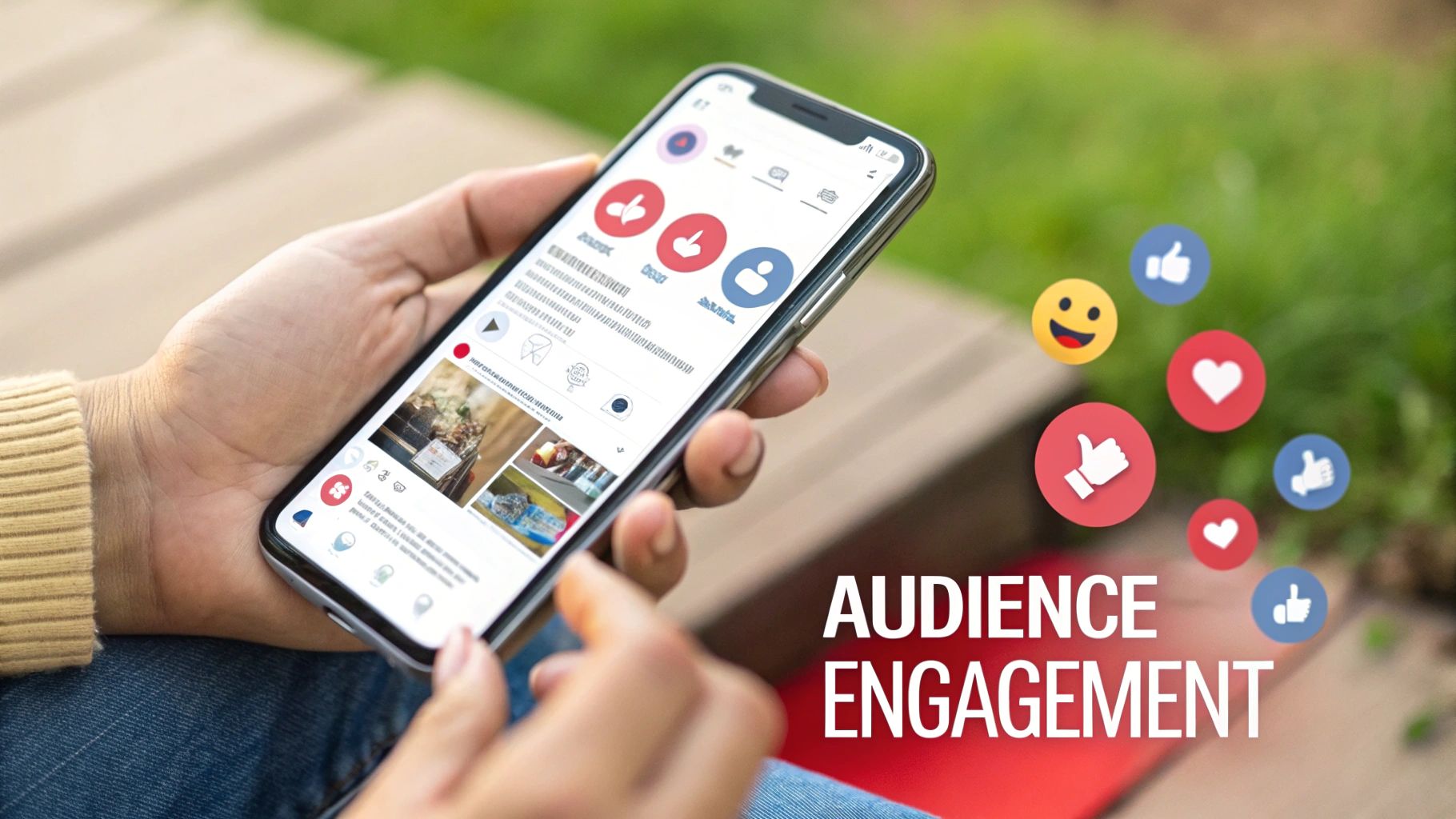
Picking the right provider for content marketing services is one of the biggest calls you’ll make. This isn't just about finding someone who can string a sentence together; it’s about building a partnership that fuels real business growth. A great partner gets in sync with your goals and effectively becomes an extension of your team.
The decision demands more than just a quick glance at a portfolio. You need to look for specific traits that show a provider is set up to deliver results, not just tick boxes. The gap between a simple content writer and a true strategic partner can be the difference between spinning your wheels and gaining serious traction.
Evaluate Genuine Industry Specialisation
Lots of agencies say they’re experts in everything but a real specialist will have deep, provable experience in your specific field. A partner with a background in your industry—whether it's automotive, tourism or energy—already understands the quirks of your audience and the unique hurdles you face. They speak your language from day one.
This specialisation means they don't need months to get up to speed. They can jump straight in, creating insightful, authoritative content that actually connects with your customers. When you’re vetting potential partners, always ask for case studies and examples of their work with businesses like yours.
A huge part of this is deciding whether to hire in-house or partner with an agency. For a deeper dive, check out our guide on why an agency often wins over a single employee for these kinds of specialised tasks.
Look for Strategic Guidance Not Just Production
A content producer will take your order and deliver an article. A strategic partner will ask "why?" They’ll help you sharpen that order to better hit your business goals. They should be obsessed with your objectives, offering proactive advice and shaping your content plan to get the biggest bang for your buck.
This means seeing the bigger picture, not just individual blog posts. A strategic provider helps you build a proper content engine that supports your entire marketing and sales funnel, from grabbing the attention of new visitors to turning them into loyal customers.
The best content partners are not just vendors; they are consultants. They challenge your assumptions and bring fresh ideas to the table, all with the aim of delivering a tangible return on your investment.
To spot a strategic thinker, pay attention to the questions they ask you. Are they digging into your business model, customer lifetime value and sales process? Or are they just asking about word counts and deadlines? The first one is a partner invested in your success.
Ask the Right Questions During Vetting
To make a smart choice, you need to walk into those conversations armed with specific, probing questions. The way they answer will tell you everything you need to know about their process, their expertise and whether they’re the right fit.
Ready to find the right partner? This checklist will help you cut through the noise and identify a provider who can deliver real results.
Provider Evaluation Checklist
| Evaluation Area | Key Question to Ask | What to Look For in Their Answer |
|---|---|---|
| ROI & Measurement | How do you measure the ROI of your content? | A clear process for linking content performance to tangible business goals like leads and revenue, not just vanity metrics like traffic. |
| Industry Proof | Can you share a case study from a client with challenges similar to ours? | Concrete examples of success in your specific sector. Vague answers are a red flag. They should have relevant work to show you. |
| Process & Strategy | What does your content strategy and production process look like? | Look for a structured, collaborative system that includes discovery, planning, creation and regular, clear reporting. |
| Team Expertise | Who, specifically, will be working on our account? | Transparency about the actual team members. You want to know the experience level of the people who will be hands-on with your brand. |
By asking these critical questions, you can see past the sales pitch and get a genuine feel for how each provider operates. This thorough vetting process helps you find a partner who not only meets your needs but also clicks with your company culture, setting you both up for long-term success.
Measuring the Real-World Impact of Your Content
So, you’re investing in content marketing services . That’s a great first step but how do you know if it’s actually paying off? To really prove the value of your content, you have to look beyond surface-level numbers like 'likes' or 'shares'. True measurement is about tracking how your content influences the entire customer journey, from their very first visit right through to the final sale.
This means drawing a straight line from your content efforts to tangible business growth. By keeping an eye on the right metrics at each stage, you can build a clear picture of your return on investment and start making much smarter decisions about where to put your budget next.
Top-of-Funnel Metrics for Brand Awareness
At the top of the funnel, your main goal is simple: attract a new audience and make them aware your brand even exists. The content here is all about answering broad questions and grabbing that initial flicker of interest. It’s about getting found.
The key numbers to watch at this stage include:
- Organic Traffic: This shows how many people are finding your website through search engines like Google. A steady climb here is a great sign that your SEO and content are working together.
- Search Engine Rankings: Tracking your position for specific keywords tells you if your content is gaining visibility for the searches that actually matter to your business.
- Backlinks: When other reputable websites link to your content, it’s a massive thumbs-up to search engines. It signals that you're a credible source, which boosts your authority across the board.
These metrics prove that your content is successfully reaching and pulling in potential customers who might never have heard of you otherwise.
Mid-Funnel Metrics for Audience Engagement
Once someone lands on your site, the next challenge is to keep them there and start building a relationship. Mid-funnel content is designed to engage this audience, earn their trust and nudge them towards taking the next step. You want to turn a casual visitor into a warm lead.
Effective mid-funnel content shifts the dynamic from a one-time visit to an ongoing conversation. It proves you understand the visitor's challenges and offers them a clear path towards a solution, building the trust needed for them to commit further.
To measure this engagement, you need to focus on metrics that show genuine, active interest:
- Email Sign-ups: When a visitor subscribes to your newsletter, they’re giving you direct permission to land in their inbox. It’s one of the strongest signals of real interest you can get.
- Content Downloads: Tracking how many people download your guides, white papers or case studies shows they find your content valuable enough to trade their contact details for it.
- Time on Page: This metric tells you how long visitors are actually spending with your content. A higher average time suggests your articles are hitting the mark and keeping people hooked.
Bottom-of-Funnel Metrics for Conversions
This is where the rubber meets the road. Your content has to prove its worth by directly contributing to the bottom line. At this stage, your audience is seriously considering a purchase and your content is there to give them that final push over the finish line. The focus shifts from education to conversion.
Here, the most important metrics are the ones tied directly to revenue:
- Marketing Qualified Leads (MQLs): This tracks how many leads generated from your content are considered ready for a proper sales conversation.
- Sales Conversion Rate: This is the ultimate test. It measures the percentage of leads who become paying customers after engaging with your content.
- Customer Acquisition Cost (CAC): By analysing content's role in the sales process, you can figure out how cost-effectively it’s helping to bring in new business.
Got Questions? We've Got Answers
Stepping into the world of content marketing often brings up a few common but important questions. We’ve answered some of the queries we hear most from UK businesses to help clear things up and give you confidence.
How Much Do Content Marketing Services Cost in the UK?
There’s no one-size-fits-all price tag, as the cost really depends on what you need and who you partner with. Generally, you’ll find a few common ways agencies and freelancers structure their pricing:
- Monthly Retainers: Perfect for a consistent, ongoing strategy. A typical retainer can range from £1,500 to £5,000+ per month and usually covers everything from strategy and creation to distribution and reporting.
- Project-Based Fees: If you have a one-off job, like an ebook or a full website rewrite, you'll pay a fixed price. This could be a few hundred pounds for a single article or run into the thousands for a major project.
- Hourly Rates: Many freelancers and consultants charge by the hour. Depending on their experience, you can expect rates from £40 to over £150 .
How Long Does It Take to See Results?
Content marketing is a marathon, not a sprint. While you might spot some early wins like a jump in social media engagement, the real, meaningful business results take a bit of time to build up.
You should expect to see tangible results, like a noticeable increase in organic traffic and lead generation, within 6 to 12 months . This gives the strategy time to bed in, for search engines to find and index your content, and for your authority to grow.
Patience is the name of the game here. The real power comes from the cumulative effect of consistent, high-quality content that drives sustainable, long-term growth.
Can My Small Business Benefit From These Services?
Absolutely. Content marketing isn't just a game for big corporations with bottomless budgets. One of its greatest strengths is that it's completely scalable, making it a perfect fit for small and medium-sized businesses (SMEs).
A good partner will craft a focused strategy that hones in on your specific niche, making every pound you spend work that much harder. By concentrating on a few high-impact activities—like nailing your local SEO or creating targeted blog content—even a small business can compete effectively and build a genuinely loyal customer base.
Ready to see how a bespoke content strategy can transform your business? Superhub specialises in creating powerful content marketing programmes for businesses in the automotive, tourism and energy sectors. Get in touch today to discuss your goals.


